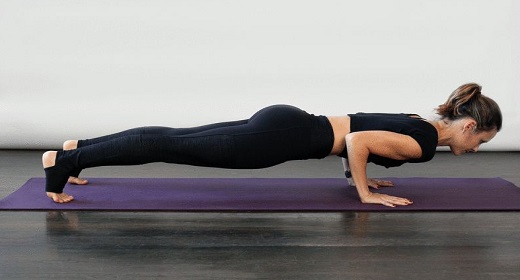by Gabrielle Kassel:Unless you’ve been living under a rock for the past 5,000 years, you’ve heard about the many benefits of yoga…
A regular yoga practice can erase muscle aches, lead to a better night of sleep, give you a sunnier disposition, and improve your mental focus—and that’s just the start.
But while the mental and emotional benefits of yoga are well-known (and scientifically well-established), there’s a lot of back-and-forth over whether pretzeling your legs into pigeon pose counts as strength work. Yoga’s robust health resume usually isn’t enough for most strength junkies to ditch their CrossFit, boxing, or HIIT routines for some sun salutations.
But when you take a quick scroll through Instagram, you’ll notice that most yogis aren’t just flexible—they’re also toned. Like, seriously toned. It begs the question: Can yoga truly sculpt a toned body?
Back up—what exactly does “tone” mean?
“Toning” is a phrase used describe the strengthening and development of certain muscle groups—usually your thighs, arms, or lower abdomen. It’s basically a watered-down term for “strength training.”
But just like lifting weights alone won’t put you in physique competition shape, not one single activity will “tone” your body into that of a svelte prima ballerina. In order for those strengthened muscles to shine through, you also need to decrease overall body fat, which means getting your heart pumping on the regular. Cardio (which uses fat for energy) is key, and eating well is mandatory because—sorry ’bout it—you can’t out-exercise a bad diet.
“Whatever your physical goals are, you need a balanced diet if the goal is to be active and healthy overall,” says Alex Silver-Fagan, ACE certified Mirror trainer and yoga instructor. Ultimately, to get a “toned” body, the work has to take place in the kitchen and the gym.
So can yoga count as strength training?
According to Adam Perlman, M.D., an integrative health and well-being expert at Duke University, yes.
“There’s no doubt about it—yoga will strengthen your muscles,” Perlman says. “It just may not be the fastest route to a stronger physique. Various styles of yoga can be effective for building muscle, and moving more energetically through poses leads to more calories and fat burned, which means more visibility of those muscles.”
Note that when Perlman says “various styles,” he’s not talking about the relaxing, candlelit Yin yoga class that you regularly fall asleep—I mean meditate—during. By all means, those classes are awesome. But they’re intended to encourage release and recovery, and building muscle requires stressing them out.
“All types of yoga offer the unique opportunity of marrying your breath to your physical movement and are a great way to tune in to your entire body. But more dynamic, intense yoga is best for building strength—and in turn, toning muscle,” says Ceasar Barajas, creator and trainer of The Journey: NEO U. “The greater the intensity and the longer the poses are held, the more they will ultimately tone.”
It turns out scientists are wondering the same thing.
Research in The Journals of Gerontology showed that a regular yoga practice was just as effective as stretching-strengthening exercises in improving functional fitness in adults above the age of 60.
A second study published in the Asian Journal of Sports Medicine had 80 participants do sun salutations six days a week for 24 weeks. At the end of the experiment, these newly minted-yogis’ rep max bench press and shoulder press showed a significant increase.
One (super-small) study conducted by the University of Wisconsin-La Crosse asked 15 subjects to practice yoga for 55 minutes three days a week for eight weeks. At the end, researchers noticed an improvement in their subjects’ strength and endurance.
So what are the best yoga poses for toning?
There are a ton! “Many yoga poses tone different muscle groups in the body by requiring the yogi to support their body weight,” Perlman says.
With that in mind, we asked yoga experts to share their favorite poses for muscle growth and strengthening. The best part? Absolutely zero of them were poses we’d never heard of before. Consider the below your cheat sheet for mastering muscle-making yoga moves.
1. Bridge Pose
Setu Bandha Sarvangasana
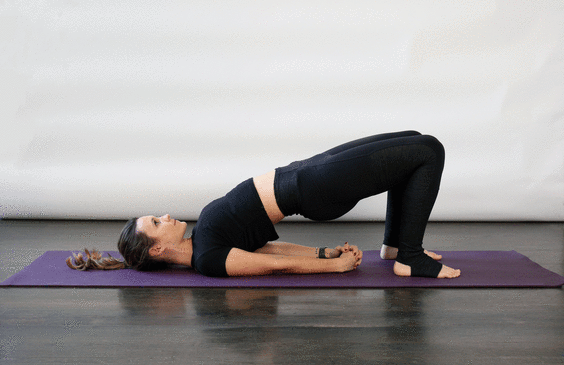
“Do this pose to strengthen the muscles in your thighs and your glutes,” Perlman says.
Start lying on your back, arms at your sides, with your palms facing down. Bend your knees, keeping them hips-width apart. Try to get your heels as close to your butt as you can (you should be able to touch them with your fingers). As you exhale, press your heels into the floor to lift your lower back off the floor. For a bigger backbend, you can shimmy your shoulders together and intertwine your fingers behind your back. Hold the pose for a couple of breaths and lower your body down. Repeat at least 3 times.
2. Plank Pose
Phalakasana
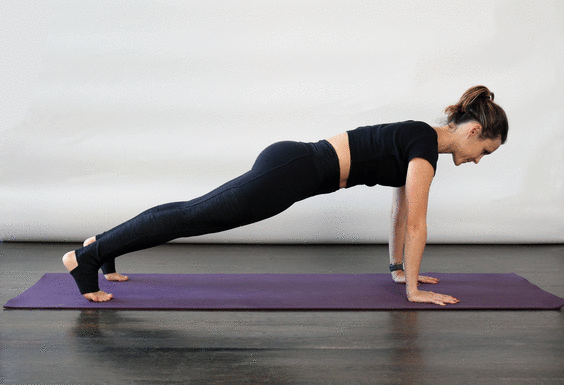
“The abductors, obliques, glutes, and shoulders will get stronger thanks to the static nature of this pose. When done consistently—at least twice a week—this pose can help develop a lean and strong midsection,” says Barrie Risman, yoga instructor and co-director of the World Spine Care Yoga Project.
Start on all fours with your fingers spread slightly. Step one foot back and then the other. Your shoulders should be stacked over your wrists while your heels press toward the back of the room. Tuck your tailbone so your butt isn’t sticking up in the air and puff up the space between your shoulder blades to make sure that your chest isn’t sinking. Squeeze your quads and glutes and breathe. Hold for anywhere from 30 seconds to three minutes (go you!). Repeat 3-5 times, resting as needed between sets.
3. Four-Limbed Staff Pose
Chaturanga Dandasana
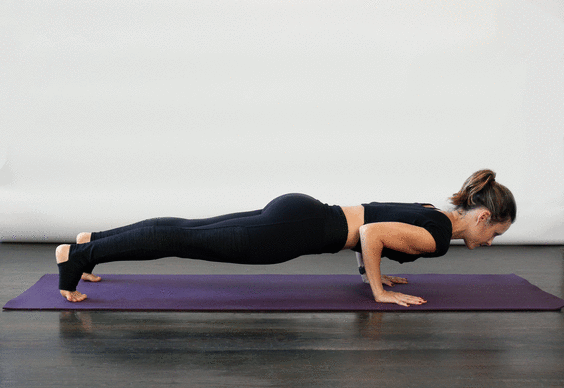
“Chaturanga is a transitional posture, but it’s not one to be rushed through!” says Jane Kivnik, an instructor at Y7 Studio in Brooklyn. “If executed properly, chaturanga strengthens not only the biceps, triceps, and shoulders, but also the abdominal wall . It’s challenging, so it demands our focus and form—if the mind wanders off, it’s an opportunity to return to the present and re-engage.”
Start in plank pose. As you inhale, scoot onto your tiptoes so your shoulders travel slightly past your fingertips. Squeezing your elbows and biceps in toward your sides, lower halfway down in one straight line and exhale. Feel like you’re doing a half-push-up? Good! Engage your lower abs to keep your butt in line with the rest of your body and elongate your neck by keeping your gaze forward and down. Chaturanga is an intense posture—if you feel your low back sagging, play it safe and practice this one by coming down onto your knees and taking the half push-up from there.
4. Chair Pose
Utkatasana
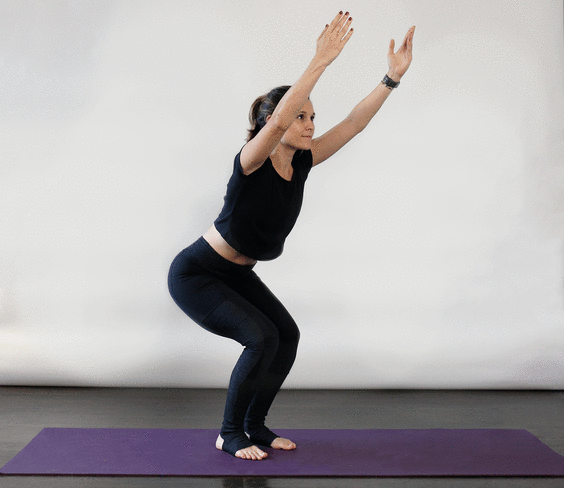
“Chair pose is the ultimate quads burner. It’s not only the quadricep muscles that will feel the burn but your gluteal muscles,” says Jill Drowne, a learning specialist at Southwest College of Naturopathic Medicine and Medical Center.
Start in mountain pose (tadasana) by standing with your feet slightly apart or your big toes together and a small space between your heels. Ground down evenly through your feet, lift up through the crown of your head, and lengthen through all four sides of your waist. Raise your arms and reach up through your fingertips while releasing your shoulder blades down your back. Sit down as if sitting into a chair (hence the name), shifting the weight toward your heels. Maintain the length in your torso while holding the pose for 5-8 breaths.
5. Crescent Lunge
Anjaneyasana
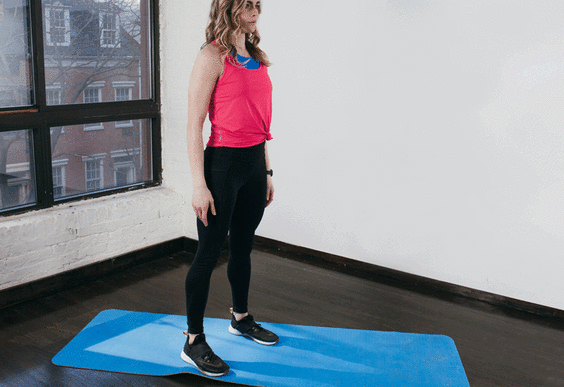
“This is a dynamic, full-body posture that creates functional flexibility, core strength, and stability and toning for the legs, butt, and upper body,” says Bethany Lyons, founder and CEO of Lyons Den Power Yoga.
To create a lunge position, step your right foot out in front of you with a 90-degree bend in the front knee and the front thigh bone parallel to the floor. Stack the back heel over the ball-mound of the back foot. Drop the tailbone down toward the floor by engaging your lower abdominal muscles. Sweep the arms overhead, shoulder-width distance with the palms facing one another. Let your pinky fingers spiral slightly inward. Engage your legs by pressing your back heel behind you and your front knee forward, paying particular attention to lift the quadriceps muscles of the back leg. Hold for 10 deep breaths.
6. Side Plank Pose
Vasisthasana
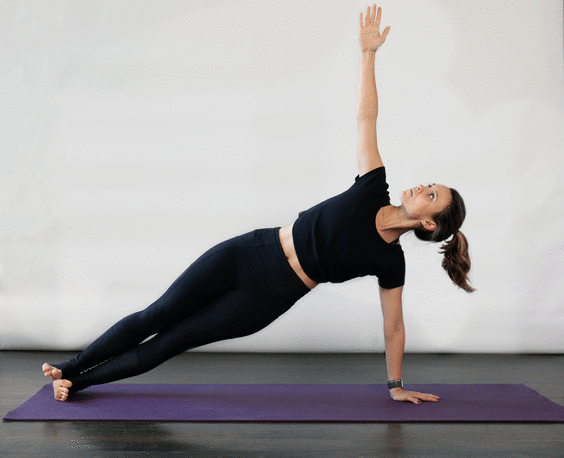
“This is another full-body, dynamic posture that generates a lot of heat as it forces the muscles to work together to create the alignment and strength necessary to hold the pose. It delivers toning for the arms, back, shoulders, core, and legs,” Lyons says.
From a high push-up position, bring the inner edges of the feet to touch and then spin your heels to the right to come onto the right-side edge of the foot. Keep the legs glued together as one and the feet fully flexed. Press down into the right hand and sweep the left hand all the way up to the sky, taking your gaze with you. The shoulders, hips, and feet should all be stacked for stability and power. Engage the core muscles and open the chest. Paying particular attention to not let the hips sink down toward the floor, take 5 breaths and then transition through high plank position to the other side. Repeat 2-3 times, taking a rest between each set.
Ready to get down (dog)?
Yoga definitely can count as strength training and can be used to tone your muscles. But remember that there’s so much more to yoga than strength, and even if you’re practicing every single day, it’s better to incorporate yoga into your regimen than to ditch everything else altogether.
And if you’re a beginner, make sure you’re learning the poses safely. “For most, the safest and most effective way is to take classes with a well-trained and qualified instructor who can not only offer guidance on the best poses to target various areas of the body, but can also help adjust poses so they are safe and appropriate for each individual,” Pearlman says.







